Development Theories Case Study
VerifiedAdded on 2022/08/19
|16
|4059
|21
AI Summary
Contribute Materials
Your contribution can guide someone’s learning journey. Share your
documents today.
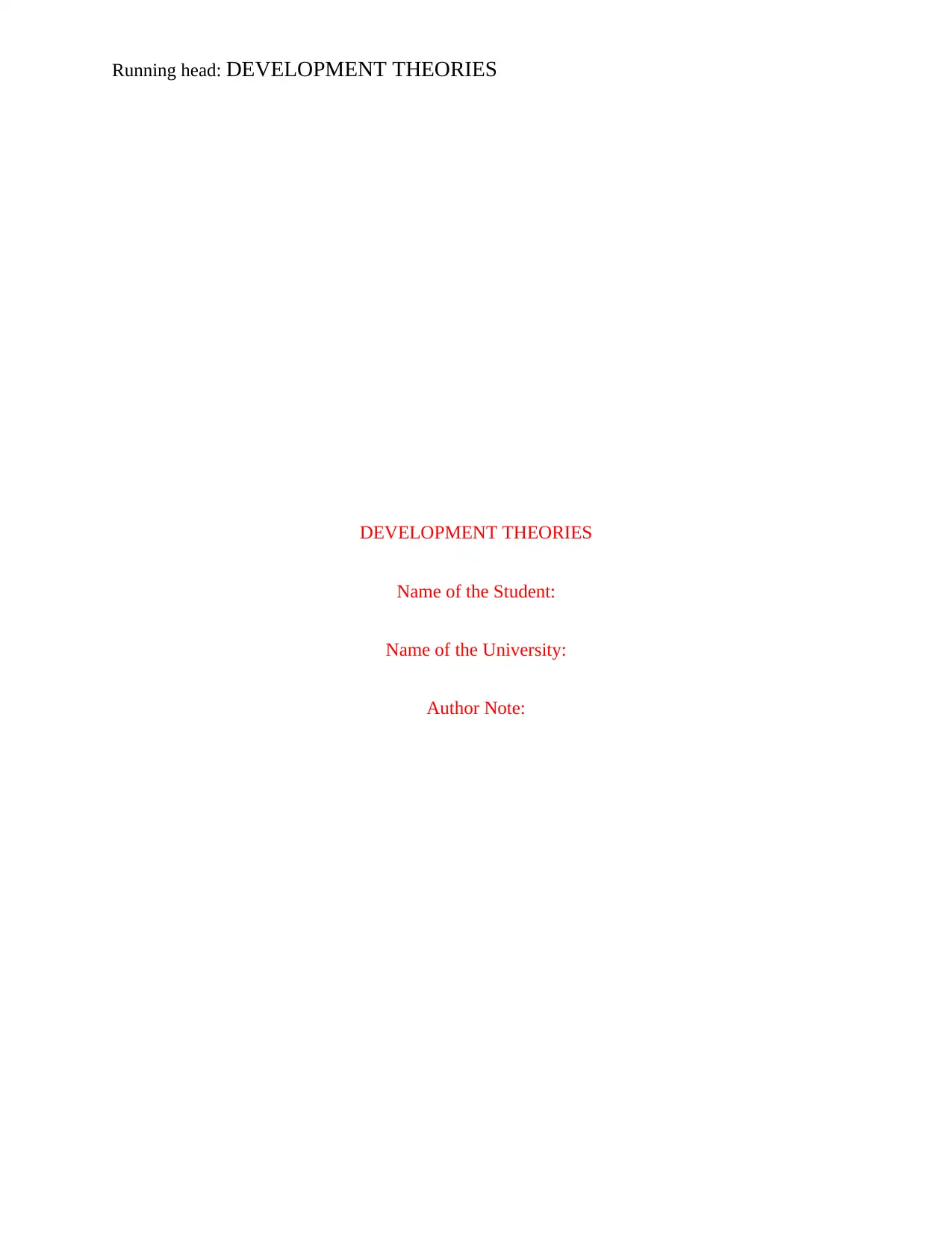
Running head: DEVELOPMENT THEORIES
DEVELOPMENT THEORIES
Name of the Student:
Name of the University:
Author Note:
DEVELOPMENT THEORIES
Name of the Student:
Name of the University:
Author Note:
Secure Best Marks with AI Grader
Need help grading? Try our AI Grader for instant feedback on your assignments.
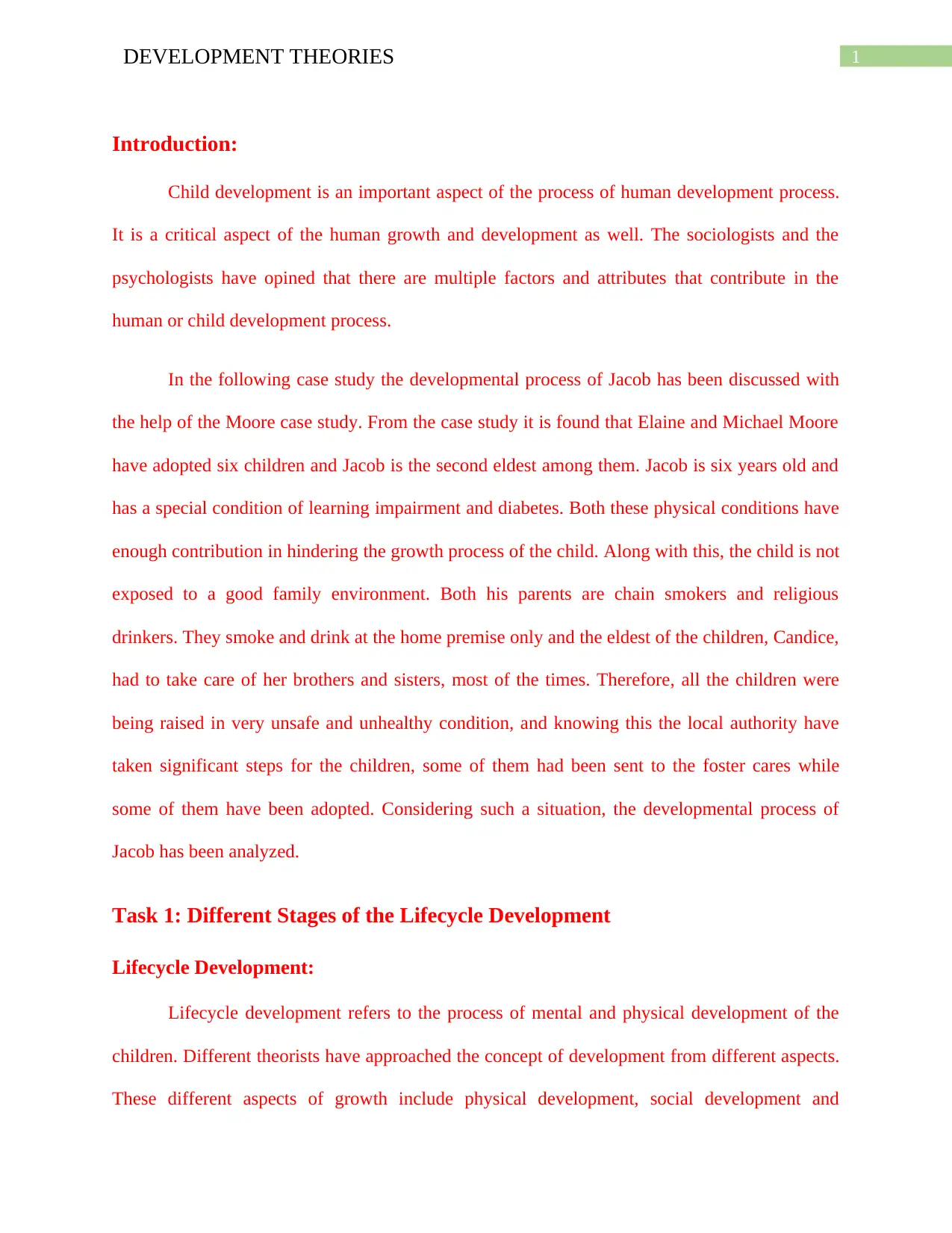
1DEVELOPMENT THEORIES
Introduction:
Child development is an important aspect of the process of human development process.
It is a critical aspect of the human growth and development as well. The sociologists and the
psychologists have opined that there are multiple factors and attributes that contribute in the
human or child development process.
In the following case study the developmental process of Jacob has been discussed with
the help of the Moore case study. From the case study it is found that Elaine and Michael Moore
have adopted six children and Jacob is the second eldest among them. Jacob is six years old and
has a special condition of learning impairment and diabetes. Both these physical conditions have
enough contribution in hindering the growth process of the child. Along with this, the child is not
exposed to a good family environment. Both his parents are chain smokers and religious
drinkers. They smoke and drink at the home premise only and the eldest of the children, Candice,
had to take care of her brothers and sisters, most of the times. Therefore, all the children were
being raised in very unsafe and unhealthy condition, and knowing this the local authority have
taken significant steps for the children, some of them had been sent to the foster cares while
some of them have been adopted. Considering such a situation, the developmental process of
Jacob has been analyzed.
Task 1: Different Stages of the Lifecycle Development
Lifecycle Development:
Lifecycle development refers to the process of mental and physical development of the
children. Different theorists have approached the concept of development from different aspects.
These different aspects of growth include physical development, social development and
Introduction:
Child development is an important aspect of the process of human development process.
It is a critical aspect of the human growth and development as well. The sociologists and the
psychologists have opined that there are multiple factors and attributes that contribute in the
human or child development process.
In the following case study the developmental process of Jacob has been discussed with
the help of the Moore case study. From the case study it is found that Elaine and Michael Moore
have adopted six children and Jacob is the second eldest among them. Jacob is six years old and
has a special condition of learning impairment and diabetes. Both these physical conditions have
enough contribution in hindering the growth process of the child. Along with this, the child is not
exposed to a good family environment. Both his parents are chain smokers and religious
drinkers. They smoke and drink at the home premise only and the eldest of the children, Candice,
had to take care of her brothers and sisters, most of the times. Therefore, all the children were
being raised in very unsafe and unhealthy condition, and knowing this the local authority have
taken significant steps for the children, some of them had been sent to the foster cares while
some of them have been adopted. Considering such a situation, the developmental process of
Jacob has been analyzed.
Task 1: Different Stages of the Lifecycle Development
Lifecycle Development:
Lifecycle development refers to the process of mental and physical development of the
children. Different theorists have approached the concept of development from different aspects.
These different aspects of growth include physical development, social development and
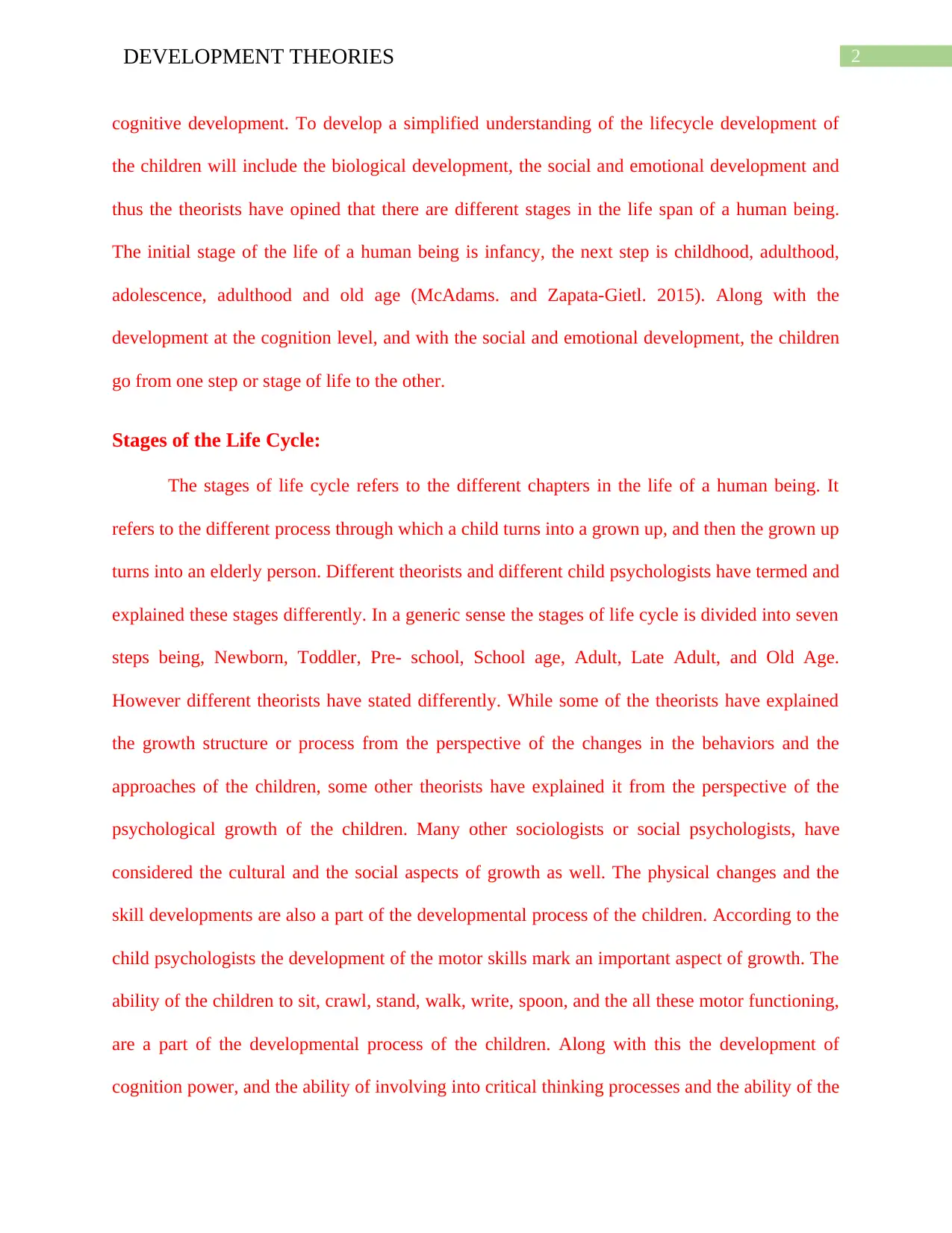
2DEVELOPMENT THEORIES
cognitive development. To develop a simplified understanding of the lifecycle development of
the children will include the biological development, the social and emotional development and
thus the theorists have opined that there are different stages in the life span of a human being.
The initial stage of the life of a human being is infancy, the next step is childhood, adulthood,
adolescence, adulthood and old age (McAdams. and Zapata-Gietl. 2015). Along with the
development at the cognition level, and with the social and emotional development, the children
go from one step or stage of life to the other.
Stages of the Life Cycle:
The stages of life cycle refers to the different chapters in the life of a human being. It
refers to the different process through which a child turns into a grown up, and then the grown up
turns into an elderly person. Different theorists and different child psychologists have termed and
explained these stages differently. In a generic sense the stages of life cycle is divided into seven
steps being, Newborn, Toddler, Pre- school, School age, Adult, Late Adult, and Old Age.
However different theorists have stated differently. While some of the theorists have explained
the growth structure or process from the perspective of the changes in the behaviors and the
approaches of the children, some other theorists have explained it from the perspective of the
psychological growth of the children. Many other sociologists or social psychologists, have
considered the cultural and the social aspects of growth as well. The physical changes and the
skill developments are also a part of the developmental process of the children. According to the
child psychologists the development of the motor skills mark an important aspect of growth. The
ability of the children to sit, crawl, stand, walk, write, spoon, and the all these motor functioning,
are a part of the developmental process of the children. Along with this the development of
cognition power, and the ability of involving into critical thinking processes and the ability of the
cognitive development. To develop a simplified understanding of the lifecycle development of
the children will include the biological development, the social and emotional development and
thus the theorists have opined that there are different stages in the life span of a human being.
The initial stage of the life of a human being is infancy, the next step is childhood, adulthood,
adolescence, adulthood and old age (McAdams. and Zapata-Gietl. 2015). Along with the
development at the cognition level, and with the social and emotional development, the children
go from one step or stage of life to the other.
Stages of the Life Cycle:
The stages of life cycle refers to the different chapters in the life of a human being. It
refers to the different process through which a child turns into a grown up, and then the grown up
turns into an elderly person. Different theorists and different child psychologists have termed and
explained these stages differently. In a generic sense the stages of life cycle is divided into seven
steps being, Newborn, Toddler, Pre- school, School age, Adult, Late Adult, and Old Age.
However different theorists have stated differently. While some of the theorists have explained
the growth structure or process from the perspective of the changes in the behaviors and the
approaches of the children, some other theorists have explained it from the perspective of the
psychological growth of the children. Many other sociologists or social psychologists, have
considered the cultural and the social aspects of growth as well. The physical changes and the
skill developments are also a part of the developmental process of the children. According to the
child psychologists the development of the motor skills mark an important aspect of growth. The
ability of the children to sit, crawl, stand, walk, write, spoon, and the all these motor functioning,
are a part of the developmental process of the children. Along with this the development of
cognition power, and the ability of involving into critical thinking processes and the ability of the
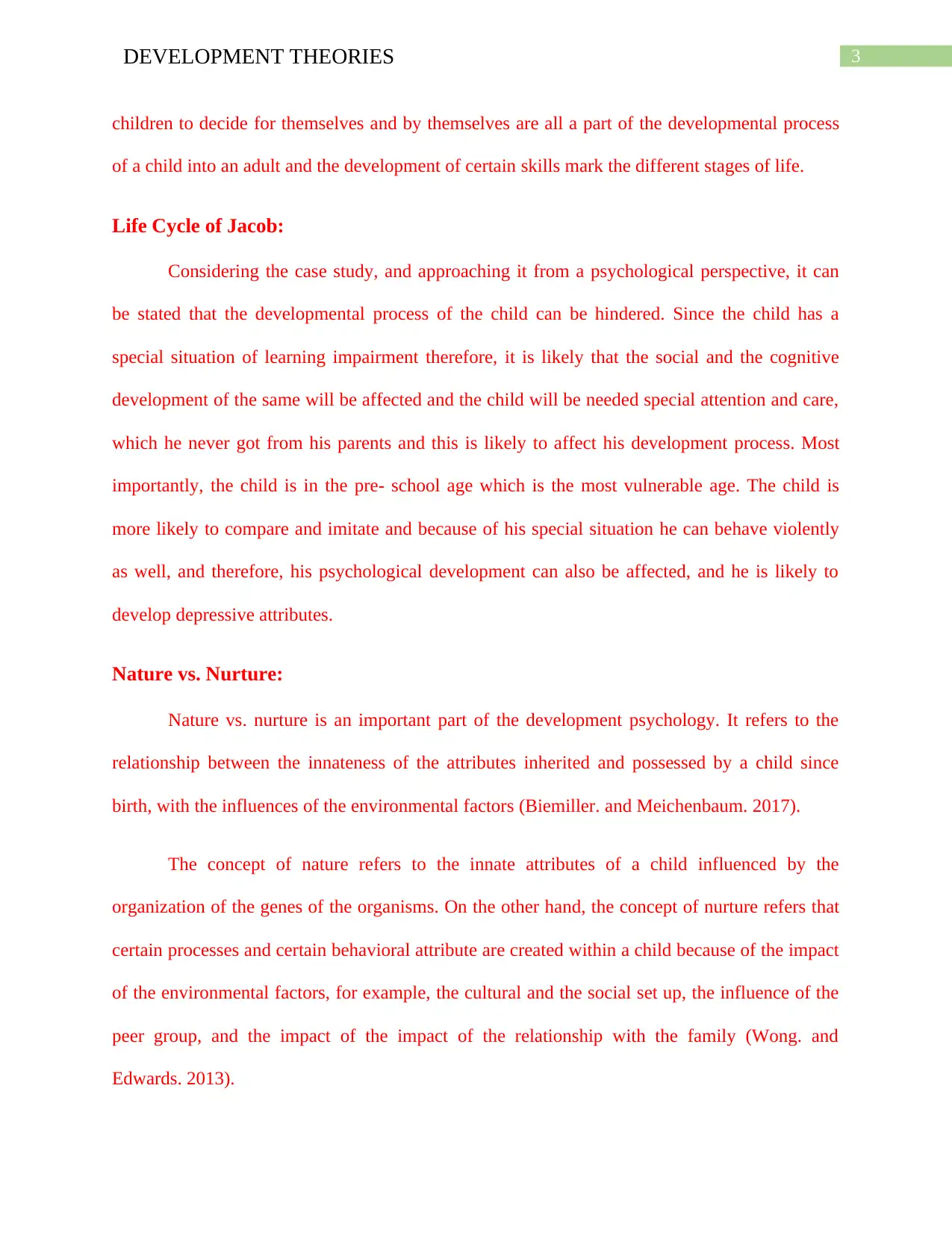
3DEVELOPMENT THEORIES
children to decide for themselves and by themselves are all a part of the developmental process
of a child into an adult and the development of certain skills mark the different stages of life.
Life Cycle of Jacob:
Considering the case study, and approaching it from a psychological perspective, it can
be stated that the developmental process of the child can be hindered. Since the child has a
special situation of learning impairment therefore, it is likely that the social and the cognitive
development of the same will be affected and the child will be needed special attention and care,
which he never got from his parents and this is likely to affect his development process. Most
importantly, the child is in the pre- school age which is the most vulnerable age. The child is
more likely to compare and imitate and because of his special situation he can behave violently
as well, and therefore, his psychological development can also be affected, and he is likely to
develop depressive attributes.
Nature vs. Nurture:
Nature vs. nurture is an important part of the development psychology. It refers to the
relationship between the innateness of the attributes inherited and possessed by a child since
birth, with the influences of the environmental factors (Biemiller. and Meichenbaum. 2017).
The concept of nature refers to the innate attributes of a child influenced by the
organization of the genes of the organisms. On the other hand, the concept of nurture refers that
certain processes and certain behavioral attribute are created within a child because of the impact
of the environmental factors, for example, the cultural and the social set up, the influence of the
peer group, and the impact of the impact of the relationship with the family (Wong. and
Edwards. 2013).
children to decide for themselves and by themselves are all a part of the developmental process
of a child into an adult and the development of certain skills mark the different stages of life.
Life Cycle of Jacob:
Considering the case study, and approaching it from a psychological perspective, it can
be stated that the developmental process of the child can be hindered. Since the child has a
special situation of learning impairment therefore, it is likely that the social and the cognitive
development of the same will be affected and the child will be needed special attention and care,
which he never got from his parents and this is likely to affect his development process. Most
importantly, the child is in the pre- school age which is the most vulnerable age. The child is
more likely to compare and imitate and because of his special situation he can behave violently
as well, and therefore, his psychological development can also be affected, and he is likely to
develop depressive attributes.
Nature vs. Nurture:
Nature vs. nurture is an important part of the development psychology. It refers to the
relationship between the innateness of the attributes inherited and possessed by a child since
birth, with the influences of the environmental factors (Biemiller. and Meichenbaum. 2017).
The concept of nature refers to the innate attributes of a child influenced by the
organization of the genes of the organisms. On the other hand, the concept of nurture refers that
certain processes and certain behavioral attribute are created within a child because of the impact
of the environmental factors, for example, the cultural and the social set up, the influence of the
peer group, and the impact of the impact of the relationship with the family (Wong. and
Edwards. 2013).
Secure Best Marks with AI Grader
Need help grading? Try our AI Grader for instant feedback on your assignments.
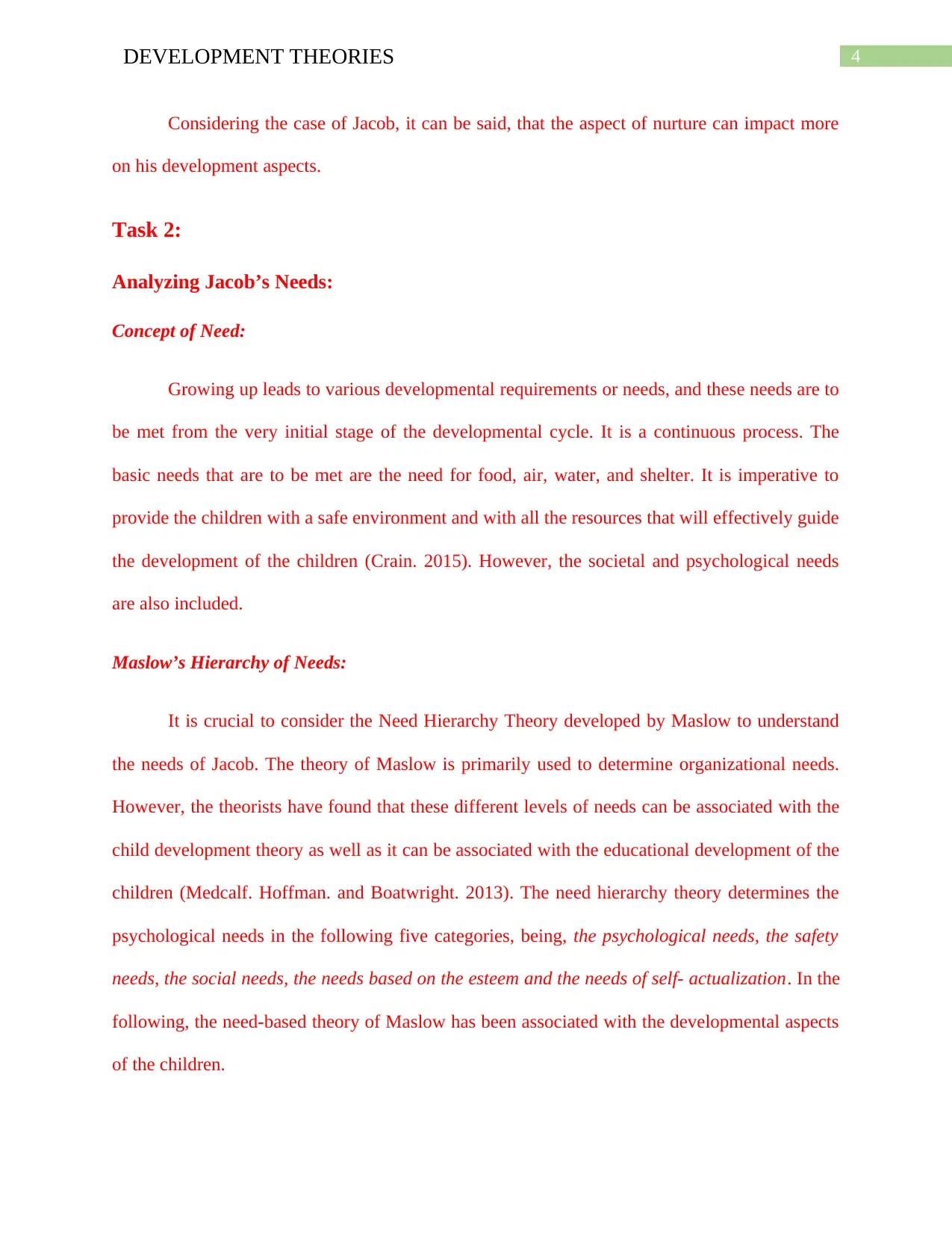
4DEVELOPMENT THEORIES
Considering the case of Jacob, it can be said, that the aspect of nurture can impact more
on his development aspects.
Task 2:
Analyzing Jacob’s Needs:
Concept of Need:
Growing up leads to various developmental requirements or needs, and these needs are to
be met from the very initial stage of the developmental cycle. It is a continuous process. The
basic needs that are to be met are the need for food, air, water, and shelter. It is imperative to
provide the children with a safe environment and with all the resources that will effectively guide
the development of the children (Crain. 2015). However, the societal and psychological needs
are also included.
Maslow’s Hierarchy of Needs:
It is crucial to consider the Need Hierarchy Theory developed by Maslow to understand
the needs of Jacob. The theory of Maslow is primarily used to determine organizational needs.
However, the theorists have found that these different levels of needs can be associated with the
child development theory as well as it can be associated with the educational development of the
children (Medcalf. Hoffman. and Boatwright. 2013). The need hierarchy theory determines the
psychological needs in the following five categories, being, the psychological needs, the safety
needs, the social needs, the needs based on the esteem and the needs of self- actualization. In the
following, the need-based theory of Maslow has been associated with the developmental aspects
of the children.
Considering the case of Jacob, it can be said, that the aspect of nurture can impact more
on his development aspects.
Task 2:
Analyzing Jacob’s Needs:
Concept of Need:
Growing up leads to various developmental requirements or needs, and these needs are to
be met from the very initial stage of the developmental cycle. It is a continuous process. The
basic needs that are to be met are the need for food, air, water, and shelter. It is imperative to
provide the children with a safe environment and with all the resources that will effectively guide
the development of the children (Crain. 2015). However, the societal and psychological needs
are also included.
Maslow’s Hierarchy of Needs:
It is crucial to consider the Need Hierarchy Theory developed by Maslow to understand
the needs of Jacob. The theory of Maslow is primarily used to determine organizational needs.
However, the theorists have found that these different levels of needs can be associated with the
child development theory as well as it can be associated with the educational development of the
children (Medcalf. Hoffman. and Boatwright. 2013). The need hierarchy theory determines the
psychological needs in the following five categories, being, the psychological needs, the safety
needs, the social needs, the needs based on the esteem and the needs of self- actualization. In the
following, the need-based theory of Maslow has been associated with the developmental aspects
of the children.
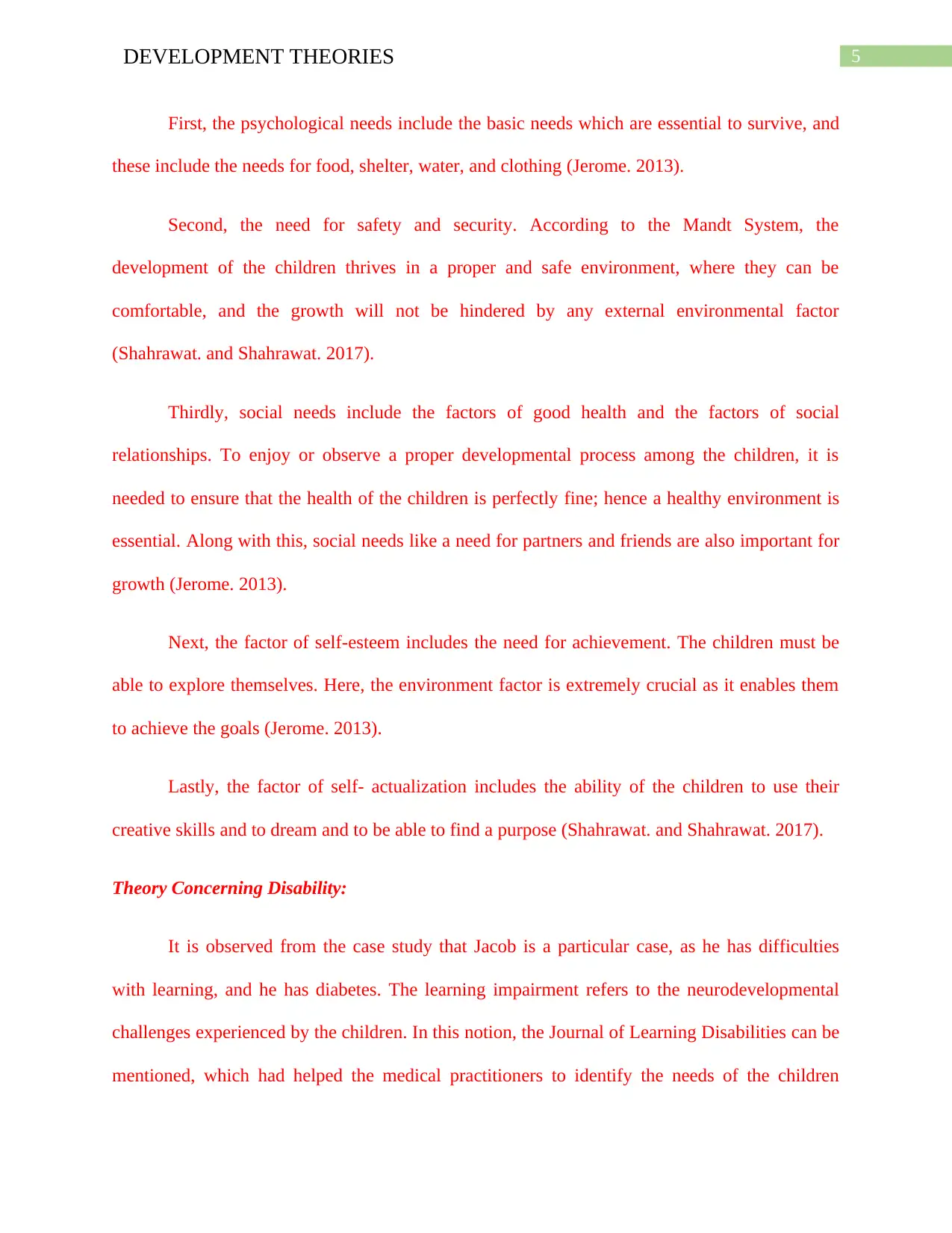
5DEVELOPMENT THEORIES
First, the psychological needs include the basic needs which are essential to survive, and
these include the needs for food, shelter, water, and clothing (Jerome. 2013).
Second, the need for safety and security. According to the Mandt System, the
development of the children thrives in a proper and safe environment, where they can be
comfortable, and the growth will not be hindered by any external environmental factor
(Shahrawat. and Shahrawat. 2017).
Thirdly, social needs include the factors of good health and the factors of social
relationships. To enjoy or observe a proper developmental process among the children, it is
needed to ensure that the health of the children is perfectly fine; hence a healthy environment is
essential. Along with this, social needs like a need for partners and friends are also important for
growth (Jerome. 2013).
Next, the factor of self-esteem includes the need for achievement. The children must be
able to explore themselves. Here, the environment factor is extremely crucial as it enables them
to achieve the goals (Jerome. 2013).
Lastly, the factor of self- actualization includes the ability of the children to use their
creative skills and to dream and to be able to find a purpose (Shahrawat. and Shahrawat. 2017).
Theory Concerning Disability:
It is observed from the case study that Jacob is a particular case, as he has difficulties
with learning, and he has diabetes. The learning impairment refers to the neurodevelopmental
challenges experienced by the children. In this notion, the Journal of Learning Disabilities can be
mentioned, which had helped the medical practitioners to identify the needs of the children
First, the psychological needs include the basic needs which are essential to survive, and
these include the needs for food, shelter, water, and clothing (Jerome. 2013).
Second, the need for safety and security. According to the Mandt System, the
development of the children thrives in a proper and safe environment, where they can be
comfortable, and the growth will not be hindered by any external environmental factor
(Shahrawat. and Shahrawat. 2017).
Thirdly, social needs include the factors of good health and the factors of social
relationships. To enjoy or observe a proper developmental process among the children, it is
needed to ensure that the health of the children is perfectly fine; hence a healthy environment is
essential. Along with this, social needs like a need for partners and friends are also important for
growth (Jerome. 2013).
Next, the factor of self-esteem includes the need for achievement. The children must be
able to explore themselves. Here, the environment factor is extremely crucial as it enables them
to achieve the goals (Jerome. 2013).
Lastly, the factor of self- actualization includes the ability of the children to use their
creative skills and to dream and to be able to find a purpose (Shahrawat. and Shahrawat. 2017).
Theory Concerning Disability:
It is observed from the case study that Jacob is a particular case, as he has difficulties
with learning, and he has diabetes. The learning impairment refers to the neurodevelopmental
challenges experienced by the children. In this notion, the Journal of Learning Disabilities can be
mentioned, which had helped the medical practitioners to identify the needs of the children
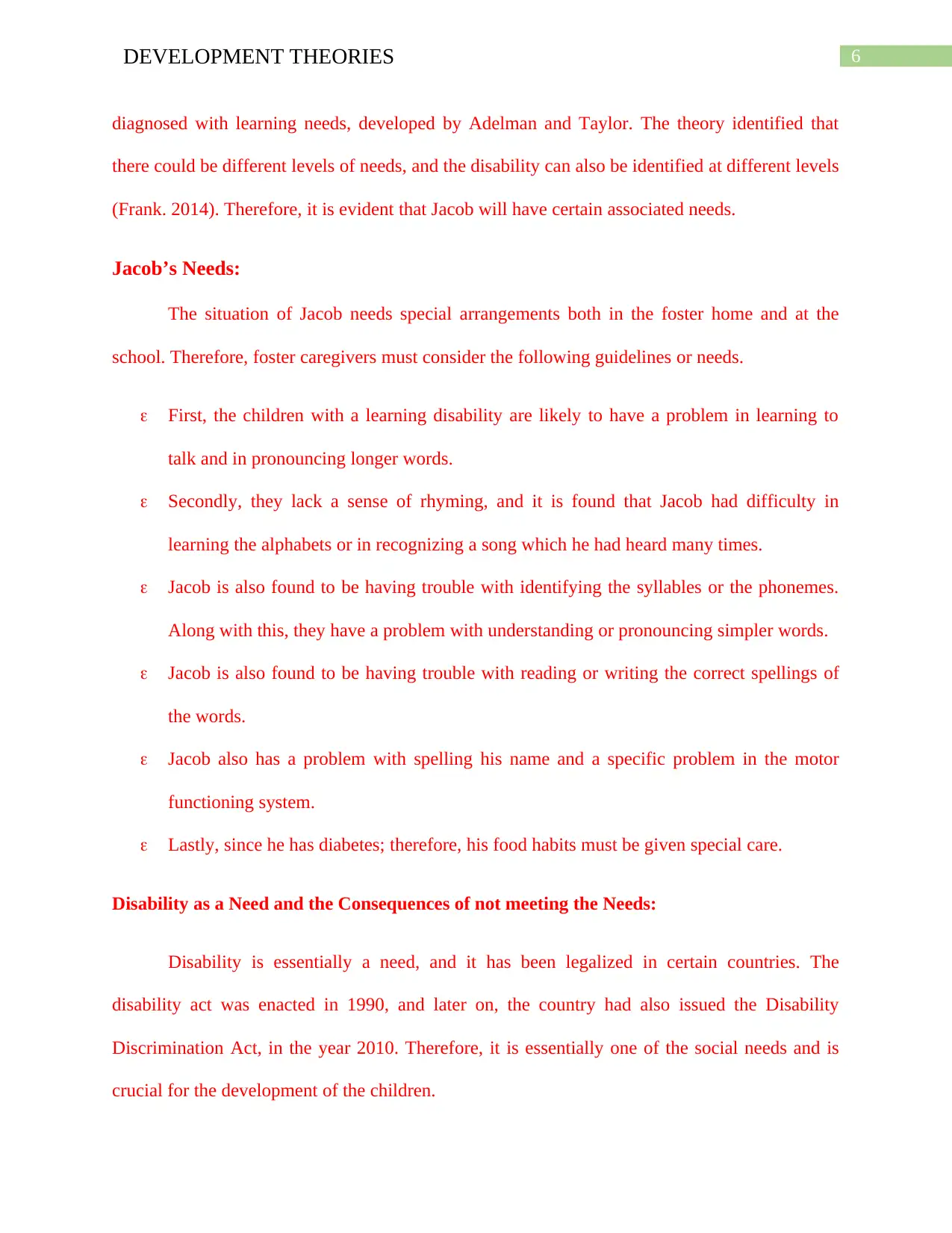
6DEVELOPMENT THEORIES
diagnosed with learning needs, developed by Adelman and Taylor. The theory identified that
there could be different levels of needs, and the disability can also be identified at different levels
(Frank. 2014). Therefore, it is evident that Jacob will have certain associated needs.
Jacob’s Needs:
The situation of Jacob needs special arrangements both in the foster home and at the
school. Therefore, foster caregivers must consider the following guidelines or needs.
First, the children with a learning disability are likely to have a problem in learning to
talk and in pronouncing longer words.
Secondly, they lack a sense of rhyming, and it is found that Jacob had difficulty in
learning the alphabets or in recognizing a song which he had heard many times.
Jacob is also found to be having trouble with identifying the syllables or the phonemes.
Along with this, they have a problem with understanding or pronouncing simpler words.
Jacob is also found to be having trouble with reading or writing the correct spellings of
the words.
Jacob also has a problem with spelling his name and a specific problem in the motor
functioning system.
Lastly, since he has diabetes; therefore, his food habits must be given special care.
Disability as a Need and the Consequences of not meeting the Needs:
Disability is essentially a need, and it has been legalized in certain countries. The
disability act was enacted in 1990, and later on, the country had also issued the Disability
Discrimination Act, in the year 2010. Therefore, it is essentially one of the social needs and is
crucial for the development of the children.
diagnosed with learning needs, developed by Adelman and Taylor. The theory identified that
there could be different levels of needs, and the disability can also be identified at different levels
(Frank. 2014). Therefore, it is evident that Jacob will have certain associated needs.
Jacob’s Needs:
The situation of Jacob needs special arrangements both in the foster home and at the
school. Therefore, foster caregivers must consider the following guidelines or needs.
First, the children with a learning disability are likely to have a problem in learning to
talk and in pronouncing longer words.
Secondly, they lack a sense of rhyming, and it is found that Jacob had difficulty in
learning the alphabets or in recognizing a song which he had heard many times.
Jacob is also found to be having trouble with identifying the syllables or the phonemes.
Along with this, they have a problem with understanding or pronouncing simpler words.
Jacob is also found to be having trouble with reading or writing the correct spellings of
the words.
Jacob also has a problem with spelling his name and a specific problem in the motor
functioning system.
Lastly, since he has diabetes; therefore, his food habits must be given special care.
Disability as a Need and the Consequences of not meeting the Needs:
Disability is essentially a need, and it has been legalized in certain countries. The
disability act was enacted in 1990, and later on, the country had also issued the Disability
Discrimination Act, in the year 2010. Therefore, it is essentially one of the social needs and is
crucial for the development of the children.
Paraphrase This Document
Need a fresh take? Get an instant paraphrase of this document with our AI Paraphraser
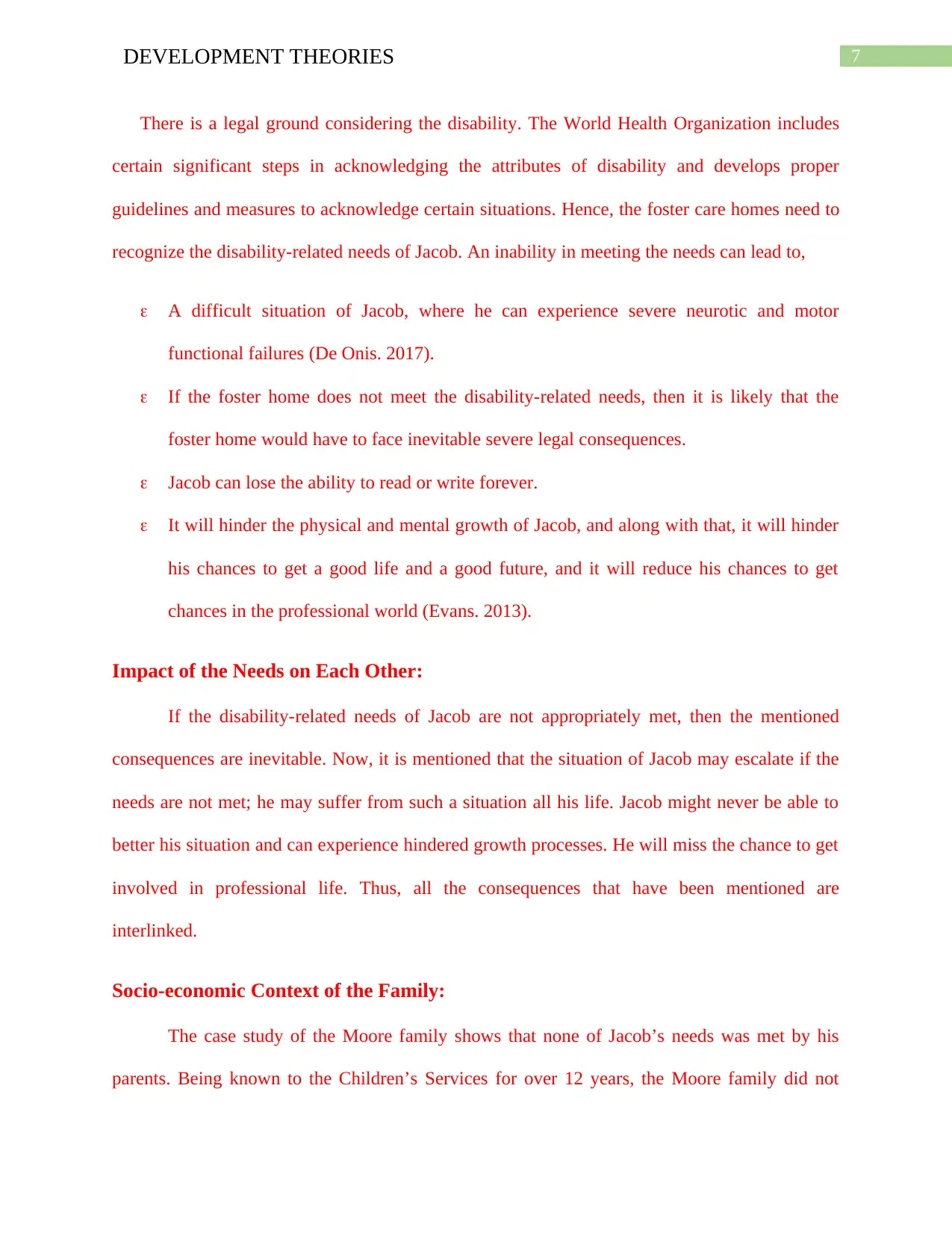
7DEVELOPMENT THEORIES
There is a legal ground considering the disability. The World Health Organization includes
certain significant steps in acknowledging the attributes of disability and develops proper
guidelines and measures to acknowledge certain situations. Hence, the foster care homes need to
recognize the disability-related needs of Jacob. An inability in meeting the needs can lead to,
A difficult situation of Jacob, where he can experience severe neurotic and motor
functional failures (De Onis. 2017).
If the foster home does not meet the disability-related needs, then it is likely that the
foster home would have to face inevitable severe legal consequences.
Jacob can lose the ability to read or write forever.
It will hinder the physical and mental growth of Jacob, and along with that, it will hinder
his chances to get a good life and a good future, and it will reduce his chances to get
chances in the professional world (Evans. 2013).
Impact of the Needs on Each Other:
If the disability-related needs of Jacob are not appropriately met, then the mentioned
consequences are inevitable. Now, it is mentioned that the situation of Jacob may escalate if the
needs are not met; he may suffer from such a situation all his life. Jacob might never be able to
better his situation and can experience hindered growth processes. He will miss the chance to get
involved in professional life. Thus, all the consequences that have been mentioned are
interlinked.
Socio-economic Context of the Family:
The case study of the Moore family shows that none of Jacob’s needs was met by his
parents. Being known to the Children’s Services for over 12 years, the Moore family did not
There is a legal ground considering the disability. The World Health Organization includes
certain significant steps in acknowledging the attributes of disability and develops proper
guidelines and measures to acknowledge certain situations. Hence, the foster care homes need to
recognize the disability-related needs of Jacob. An inability in meeting the needs can lead to,
A difficult situation of Jacob, where he can experience severe neurotic and motor
functional failures (De Onis. 2017).
If the foster home does not meet the disability-related needs, then it is likely that the
foster home would have to face inevitable severe legal consequences.
Jacob can lose the ability to read or write forever.
It will hinder the physical and mental growth of Jacob, and along with that, it will hinder
his chances to get a good life and a good future, and it will reduce his chances to get
chances in the professional world (Evans. 2013).
Impact of the Needs on Each Other:
If the disability-related needs of Jacob are not appropriately met, then the mentioned
consequences are inevitable. Now, it is mentioned that the situation of Jacob may escalate if the
needs are not met; he may suffer from such a situation all his life. Jacob might never be able to
better his situation and can experience hindered growth processes. He will miss the chance to get
involved in professional life. Thus, all the consequences that have been mentioned are
interlinked.
Socio-economic Context of the Family:
The case study of the Moore family shows that none of Jacob’s needs was met by his
parents. Being known to the Children’s Services for over 12 years, the Moore family did not
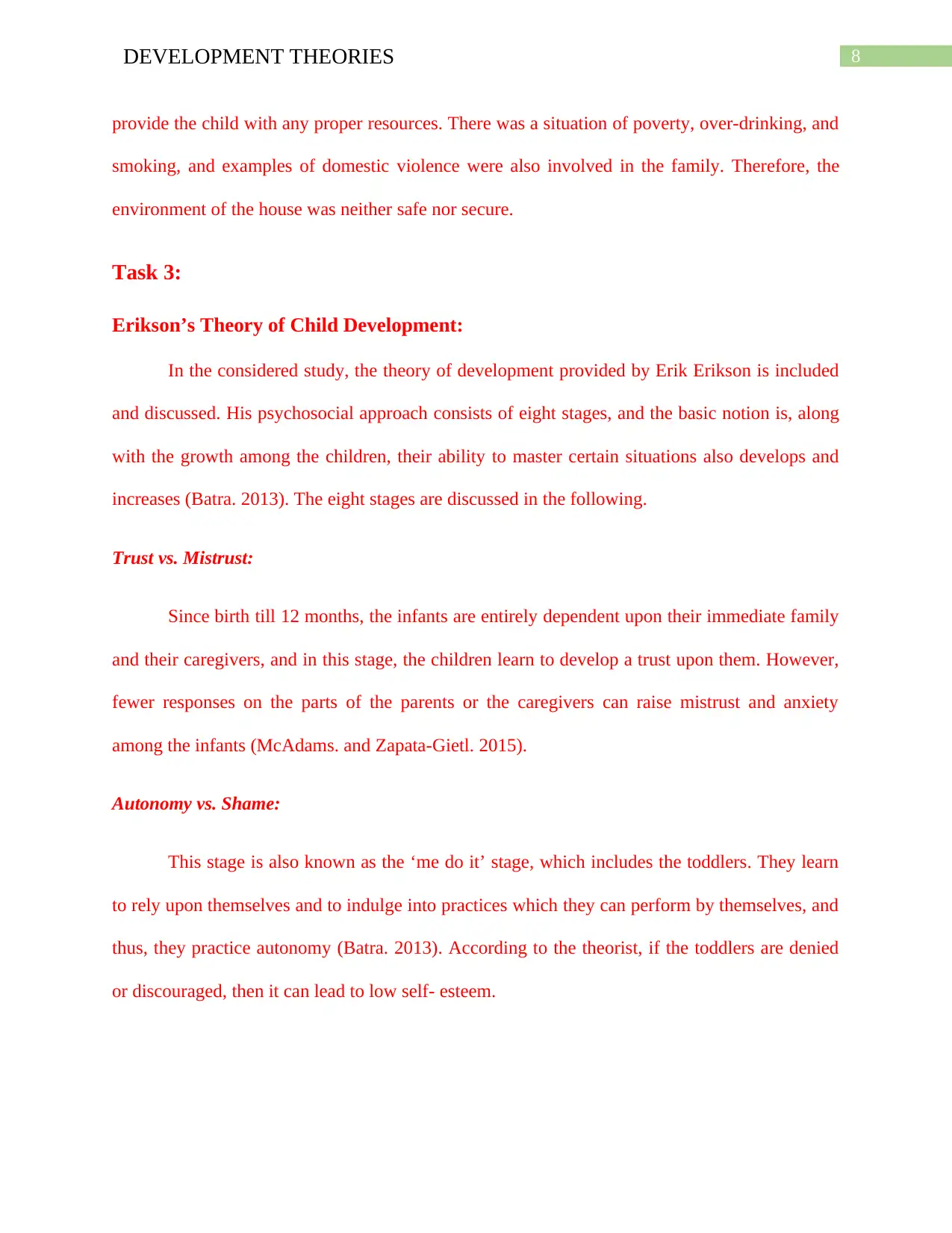
8DEVELOPMENT THEORIES
provide the child with any proper resources. There was a situation of poverty, over-drinking, and
smoking, and examples of domestic violence were also involved in the family. Therefore, the
environment of the house was neither safe nor secure.
Task 3:
Erikson’s Theory of Child Development:
In the considered study, the theory of development provided by Erik Erikson is included
and discussed. His psychosocial approach consists of eight stages, and the basic notion is, along
with the growth among the children, their ability to master certain situations also develops and
increases (Batra. 2013). The eight stages are discussed in the following.
Trust vs. Mistrust:
Since birth till 12 months, the infants are entirely dependent upon their immediate family
and their caregivers, and in this stage, the children learn to develop a trust upon them. However,
fewer responses on the parts of the parents or the caregivers can raise mistrust and anxiety
among the infants (McAdams. and Zapata-Gietl. 2015).
Autonomy vs. Shame:
This stage is also known as the ‘me do it’ stage, which includes the toddlers. They learn
to rely upon themselves and to indulge into practices which they can perform by themselves, and
thus, they practice autonomy (Batra. 2013). According to the theorist, if the toddlers are denied
or discouraged, then it can lead to low self- esteem.
provide the child with any proper resources. There was a situation of poverty, over-drinking, and
smoking, and examples of domestic violence were also involved in the family. Therefore, the
environment of the house was neither safe nor secure.
Task 3:
Erikson’s Theory of Child Development:
In the considered study, the theory of development provided by Erik Erikson is included
and discussed. His psychosocial approach consists of eight stages, and the basic notion is, along
with the growth among the children, their ability to master certain situations also develops and
increases (Batra. 2013). The eight stages are discussed in the following.
Trust vs. Mistrust:
Since birth till 12 months, the infants are entirely dependent upon their immediate family
and their caregivers, and in this stage, the children learn to develop a trust upon them. However,
fewer responses on the parts of the parents or the caregivers can raise mistrust and anxiety
among the infants (McAdams. and Zapata-Gietl. 2015).
Autonomy vs. Shame:
This stage is also known as the ‘me do it’ stage, which includes the toddlers. They learn
to rely upon themselves and to indulge into practices which they can perform by themselves, and
thus, they practice autonomy (Batra. 2013). According to the theorist, if the toddlers are denied
or discouraged, then it can lead to low self- esteem.
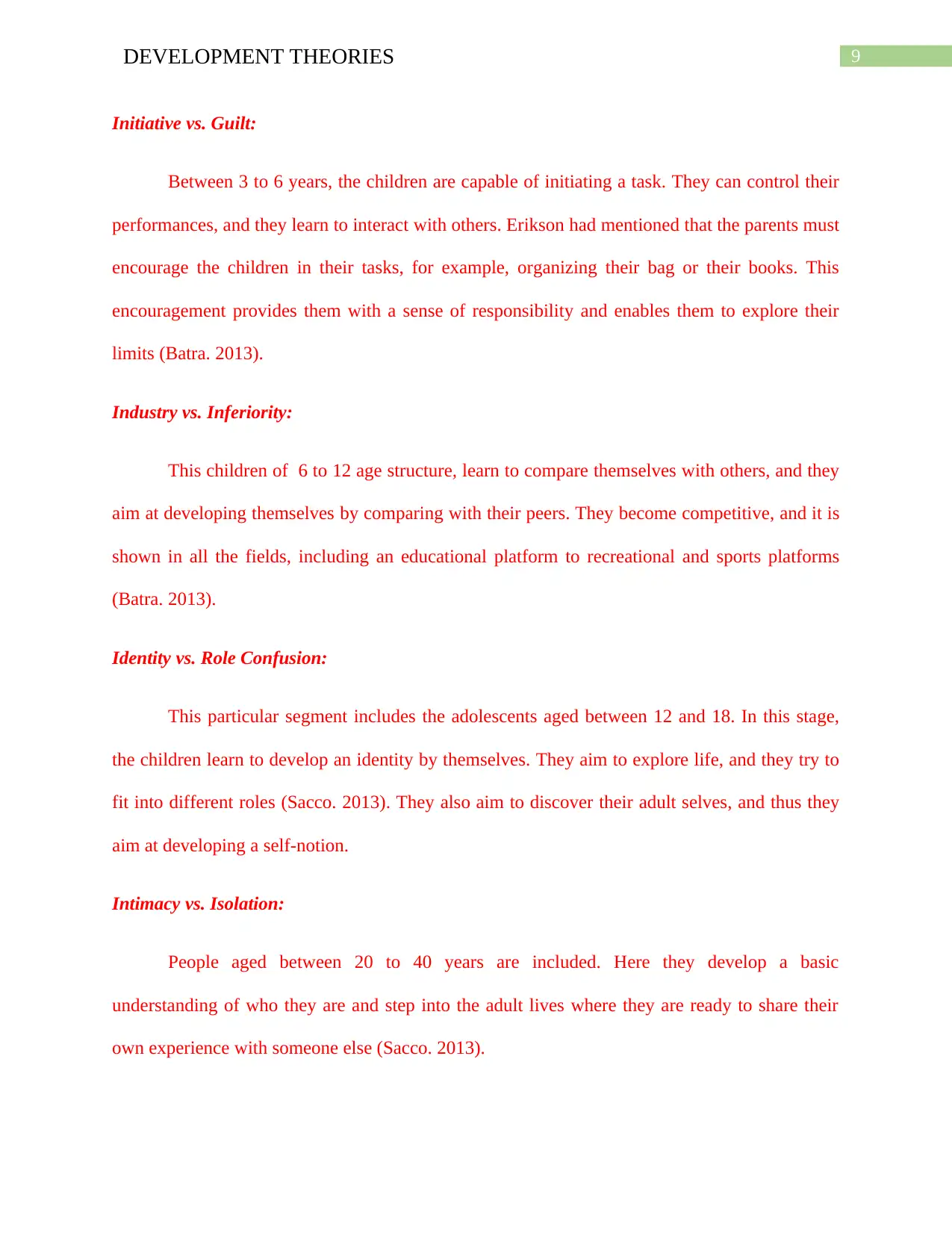
9DEVELOPMENT THEORIES
Initiative vs. Guilt:
Between 3 to 6 years, the children are capable of initiating a task. They can control their
performances, and they learn to interact with others. Erikson had mentioned that the parents must
encourage the children in their tasks, for example, organizing their bag or their books. This
encouragement provides them with a sense of responsibility and enables them to explore their
limits (Batra. 2013).
Industry vs. Inferiority:
This children of 6 to 12 age structure, learn to compare themselves with others, and they
aim at developing themselves by comparing with their peers. They become competitive, and it is
shown in all the fields, including an educational platform to recreational and sports platforms
(Batra. 2013).
Identity vs. Role Confusion:
This particular segment includes the adolescents aged between 12 and 18. In this stage,
the children learn to develop an identity by themselves. They aim to explore life, and they try to
fit into different roles (Sacco. 2013). They also aim to discover their adult selves, and thus they
aim at developing a self-notion.
Intimacy vs. Isolation:
People aged between 20 to 40 years are included. Here they develop a basic
understanding of who they are and step into the adult lives where they are ready to share their
own experience with someone else (Sacco. 2013).
Initiative vs. Guilt:
Between 3 to 6 years, the children are capable of initiating a task. They can control their
performances, and they learn to interact with others. Erikson had mentioned that the parents must
encourage the children in their tasks, for example, organizing their bag or their books. This
encouragement provides them with a sense of responsibility and enables them to explore their
limits (Batra. 2013).
Industry vs. Inferiority:
This children of 6 to 12 age structure, learn to compare themselves with others, and they
aim at developing themselves by comparing with their peers. They become competitive, and it is
shown in all the fields, including an educational platform to recreational and sports platforms
(Batra. 2013).
Identity vs. Role Confusion:
This particular segment includes the adolescents aged between 12 and 18. In this stage,
the children learn to develop an identity by themselves. They aim to explore life, and they try to
fit into different roles (Sacco. 2013). They also aim to discover their adult selves, and thus they
aim at developing a self-notion.
Intimacy vs. Isolation:
People aged between 20 to 40 years are included. Here they develop a basic
understanding of who they are and step into the adult lives where they are ready to share their
own experience with someone else (Sacco. 2013).
Secure Best Marks with AI Grader
Need help grading? Try our AI Grader for instant feedback on your assignments.
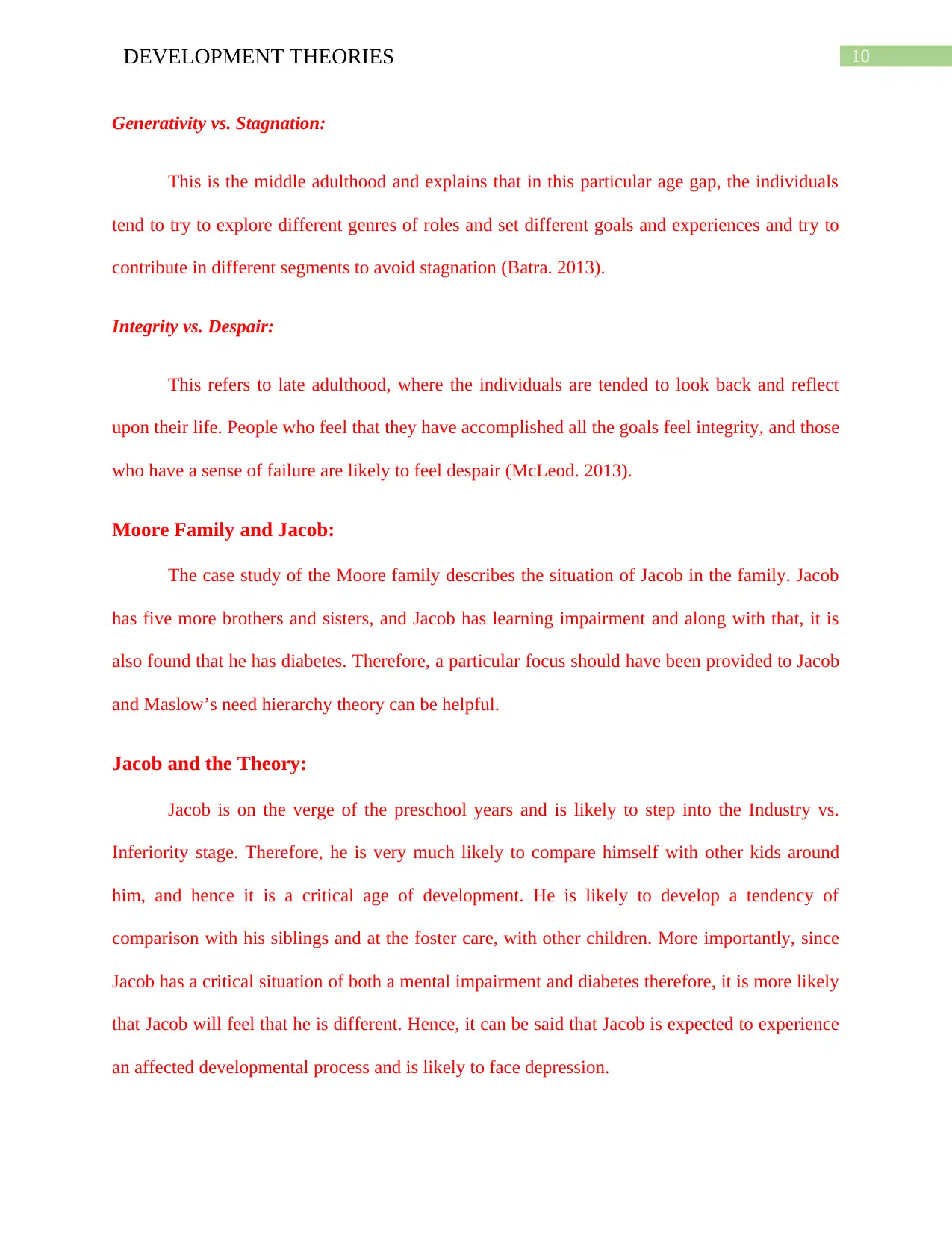
10DEVELOPMENT THEORIES
Generativity vs. Stagnation:
This is the middle adulthood and explains that in this particular age gap, the individuals
tend to try to explore different genres of roles and set different goals and experiences and try to
contribute in different segments to avoid stagnation (Batra. 2013).
Integrity vs. Despair:
This refers to late adulthood, where the individuals are tended to look back and reflect
upon their life. People who feel that they have accomplished all the goals feel integrity, and those
who have a sense of failure are likely to feel despair (McLeod. 2013).
Moore Family and Jacob:
The case study of the Moore family describes the situation of Jacob in the family. Jacob
has five more brothers and sisters, and Jacob has learning impairment and along with that, it is
also found that he has diabetes. Therefore, a particular focus should have been provided to Jacob
and Maslow’s need hierarchy theory can be helpful.
Jacob and the Theory:
Jacob is on the verge of the preschool years and is likely to step into the Industry vs.
Inferiority stage. Therefore, he is very much likely to compare himself with other kids around
him, and hence it is a critical age of development. He is likely to develop a tendency of
comparison with his siblings and at the foster care, with other children. More importantly, since
Jacob has a critical situation of both a mental impairment and diabetes therefore, it is more likely
that Jacob will feel that he is different. Hence, it can be said that Jacob is expected to experience
an affected developmental process and is likely to face depression.
Generativity vs. Stagnation:
This is the middle adulthood and explains that in this particular age gap, the individuals
tend to try to explore different genres of roles and set different goals and experiences and try to
contribute in different segments to avoid stagnation (Batra. 2013).
Integrity vs. Despair:
This refers to late adulthood, where the individuals are tended to look back and reflect
upon their life. People who feel that they have accomplished all the goals feel integrity, and those
who have a sense of failure are likely to feel despair (McLeod. 2013).
Moore Family and Jacob:
The case study of the Moore family describes the situation of Jacob in the family. Jacob
has five more brothers and sisters, and Jacob has learning impairment and along with that, it is
also found that he has diabetes. Therefore, a particular focus should have been provided to Jacob
and Maslow’s need hierarchy theory can be helpful.
Jacob and the Theory:
Jacob is on the verge of the preschool years and is likely to step into the Industry vs.
Inferiority stage. Therefore, he is very much likely to compare himself with other kids around
him, and hence it is a critical age of development. He is likely to develop a tendency of
comparison with his siblings and at the foster care, with other children. More importantly, since
Jacob has a critical situation of both a mental impairment and diabetes therefore, it is more likely
that Jacob will feel that he is different. Hence, it can be said that Jacob is expected to experience
an affected developmental process and is likely to face depression.
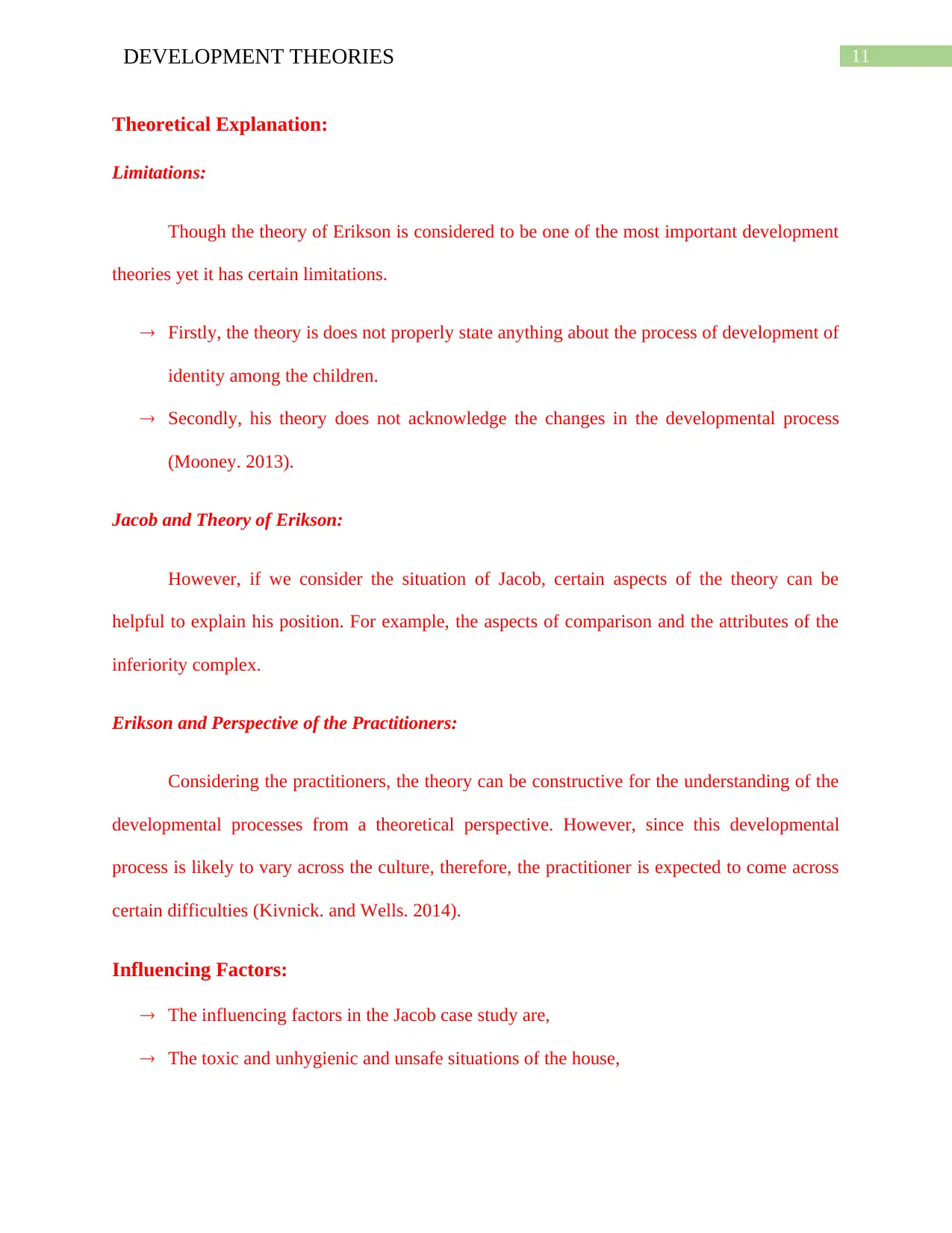
11DEVELOPMENT THEORIES
Theoretical Explanation:
Limitations:
Though the theory of Erikson is considered to be one of the most important development
theories yet it has certain limitations.
Firstly, the theory is does not properly state anything about the process of development of
identity among the children.
Secondly, his theory does not acknowledge the changes in the developmental process
(Mooney. 2013).
Jacob and Theory of Erikson:
However, if we consider the situation of Jacob, certain aspects of the theory can be
helpful to explain his position. For example, the aspects of comparison and the attributes of the
inferiority complex.
Erikson and Perspective of the Practitioners:
Considering the practitioners, the theory can be constructive for the understanding of the
developmental processes from a theoretical perspective. However, since this developmental
process is likely to vary across the culture, therefore, the practitioner is expected to come across
certain difficulties (Kivnick. and Wells. 2014).
Influencing Factors:
The influencing factors in the Jacob case study are,
The toxic and unhygienic and unsafe situations of the house,
Theoretical Explanation:
Limitations:
Though the theory of Erikson is considered to be one of the most important development
theories yet it has certain limitations.
Firstly, the theory is does not properly state anything about the process of development of
identity among the children.
Secondly, his theory does not acknowledge the changes in the developmental process
(Mooney. 2013).
Jacob and Theory of Erikson:
However, if we consider the situation of Jacob, certain aspects of the theory can be
helpful to explain his position. For example, the aspects of comparison and the attributes of the
inferiority complex.
Erikson and Perspective of the Practitioners:
Considering the practitioners, the theory can be constructive for the understanding of the
developmental processes from a theoretical perspective. However, since this developmental
process is likely to vary across the culture, therefore, the practitioner is expected to come across
certain difficulties (Kivnick. and Wells. 2014).
Influencing Factors:
The influencing factors in the Jacob case study are,
The toxic and unhygienic and unsafe situations of the house,
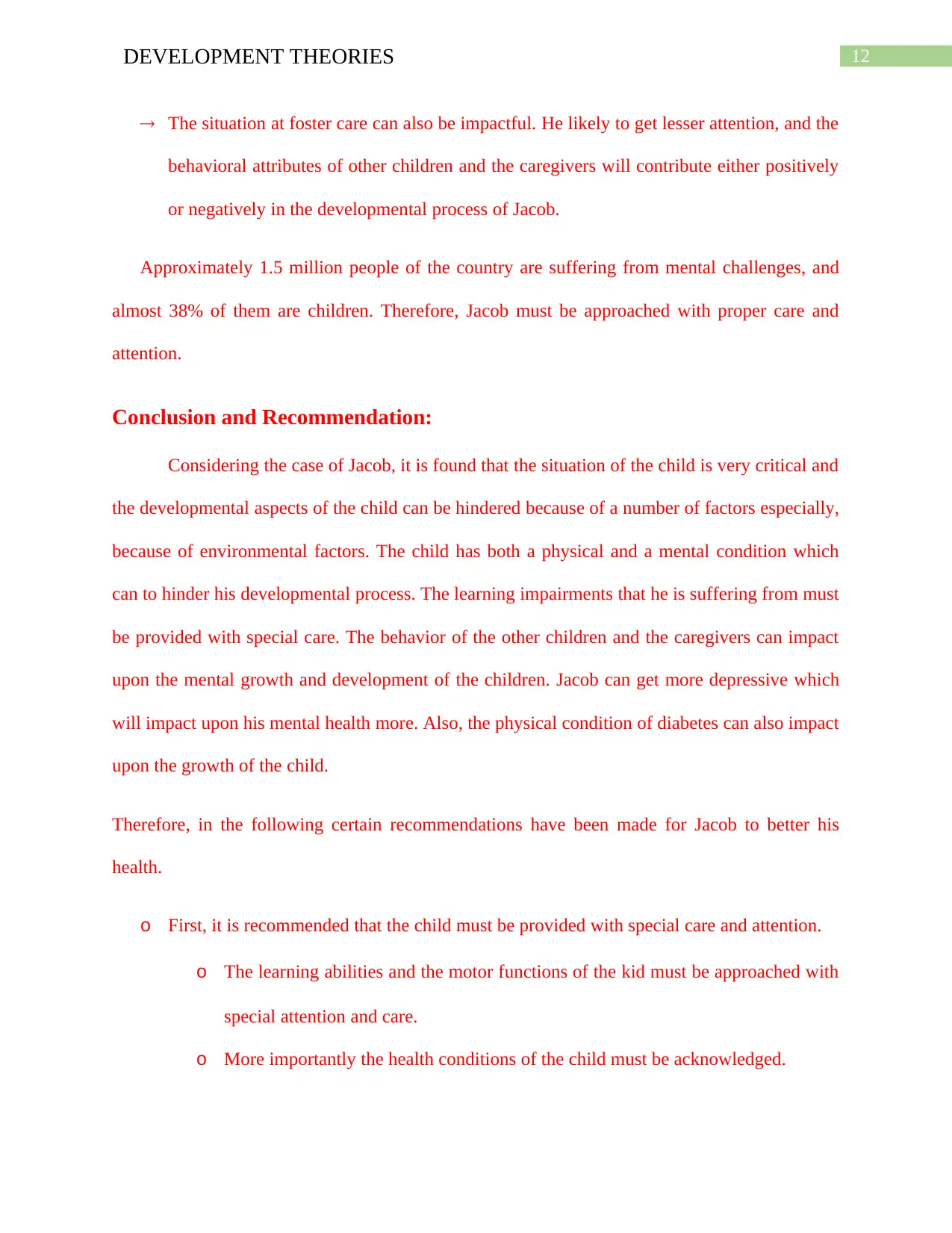
12DEVELOPMENT THEORIES
The situation at foster care can also be impactful. He likely to get lesser attention, and the
behavioral attributes of other children and the caregivers will contribute either positively
or negatively in the developmental process of Jacob.
Approximately 1.5 million people of the country are suffering from mental challenges, and
almost 38% of them are children. Therefore, Jacob must be approached with proper care and
attention.
Conclusion and Recommendation:
Considering the case of Jacob, it is found that the situation of the child is very critical and
the developmental aspects of the child can be hindered because of a number of factors especially,
because of environmental factors. The child has both a physical and a mental condition which
can to hinder his developmental process. The learning impairments that he is suffering from must
be provided with special care. The behavior of the other children and the caregivers can impact
upon the mental growth and development of the children. Jacob can get more depressive which
will impact upon his mental health more. Also, the physical condition of diabetes can also impact
upon the growth of the child.
Therefore, in the following certain recommendations have been made for Jacob to better his
health.
o First, it is recommended that the child must be provided with special care and attention.
o The learning abilities and the motor functions of the kid must be approached with
special attention and care.
o More importantly the health conditions of the child must be acknowledged.
The situation at foster care can also be impactful. He likely to get lesser attention, and the
behavioral attributes of other children and the caregivers will contribute either positively
or negatively in the developmental process of Jacob.
Approximately 1.5 million people of the country are suffering from mental challenges, and
almost 38% of them are children. Therefore, Jacob must be approached with proper care and
attention.
Conclusion and Recommendation:
Considering the case of Jacob, it is found that the situation of the child is very critical and
the developmental aspects of the child can be hindered because of a number of factors especially,
because of environmental factors. The child has both a physical and a mental condition which
can to hinder his developmental process. The learning impairments that he is suffering from must
be provided with special care. The behavior of the other children and the caregivers can impact
upon the mental growth and development of the children. Jacob can get more depressive which
will impact upon his mental health more. Also, the physical condition of diabetes can also impact
upon the growth of the child.
Therefore, in the following certain recommendations have been made for Jacob to better his
health.
o First, it is recommended that the child must be provided with special care and attention.
o The learning abilities and the motor functions of the kid must be approached with
special attention and care.
o More importantly the health conditions of the child must be acknowledged.
Paraphrase This Document
Need a fresh take? Get an instant paraphrase of this document with our AI Paraphraser
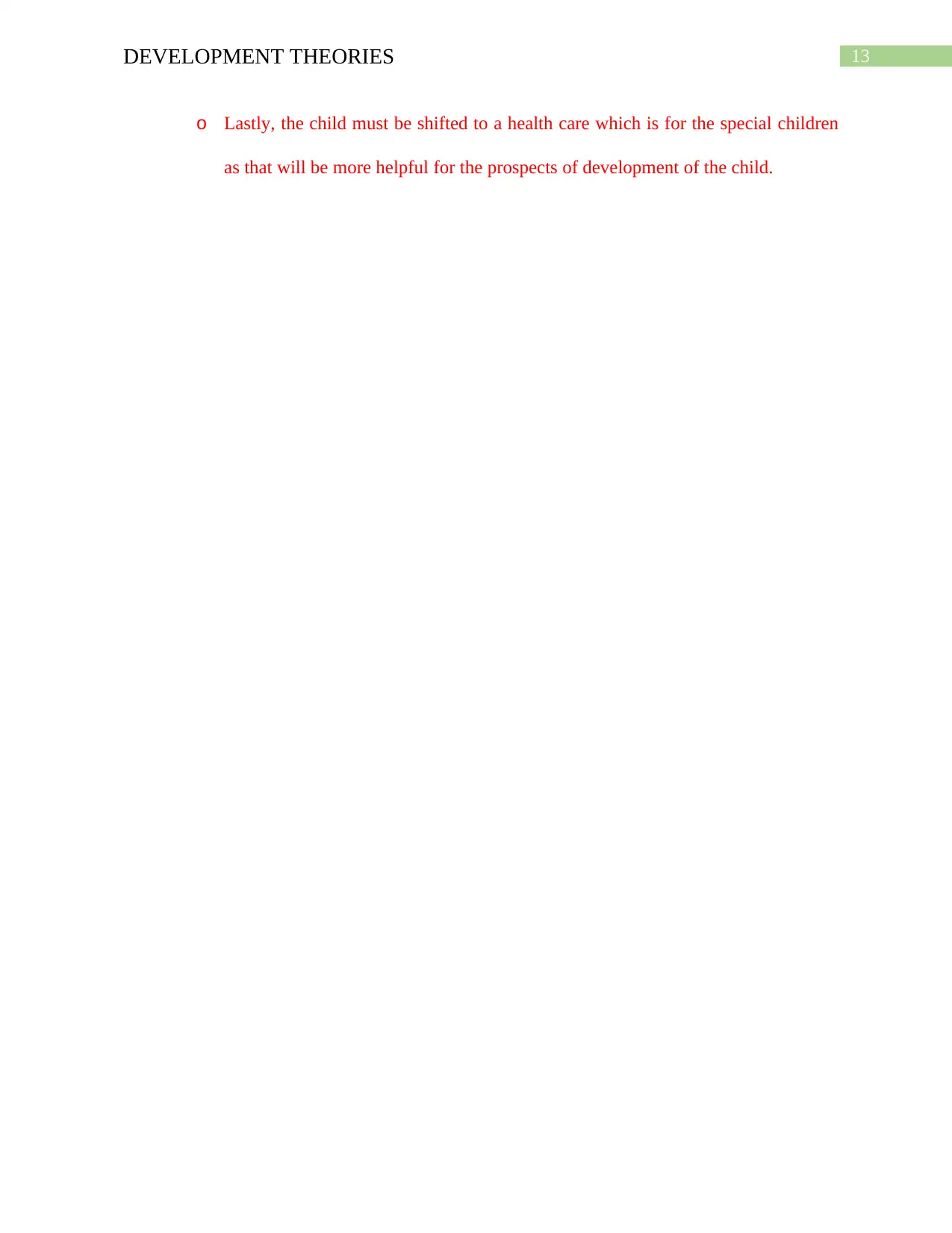
13DEVELOPMENT THEORIES
o Lastly, the child must be shifted to a health care which is for the special children
as that will be more helpful for the prospects of development of the child.
o Lastly, the child must be shifted to a health care which is for the special children
as that will be more helpful for the prospects of development of the child.
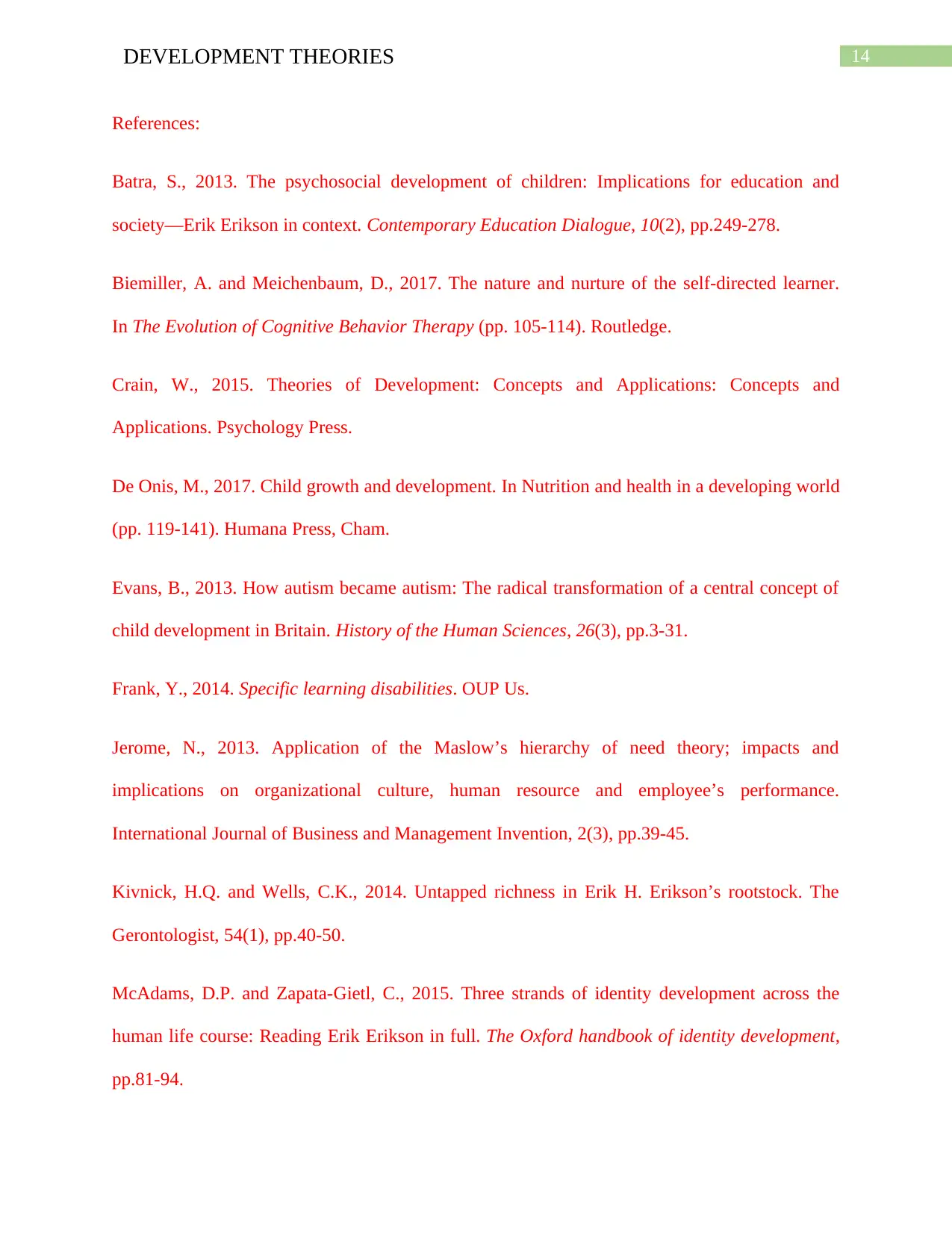
14DEVELOPMENT THEORIES
References:
Batra, S., 2013. The psychosocial development of children: Implications for education and
society—Erik Erikson in context. Contemporary Education Dialogue, 10(2), pp.249-278.
Biemiller, A. and Meichenbaum, D., 2017. The nature and nurture of the self-directed learner.
In The Evolution of Cognitive Behavior Therapy (pp. 105-114). Routledge.
Crain, W., 2015. Theories of Development: Concepts and Applications: Concepts and
Applications. Psychology Press.
De Onis, M., 2017. Child growth and development. In Nutrition and health in a developing world
(pp. 119-141). Humana Press, Cham.
Evans, B., 2013. How autism became autism: The radical transformation of a central concept of
child development in Britain. History of the Human Sciences, 26(3), pp.3-31.
Frank, Y., 2014. Specific learning disabilities. OUP Us.
Jerome, N., 2013. Application of the Maslow’s hierarchy of need theory; impacts and
implications on organizational culture, human resource and employee’s performance.
International Journal of Business and Management Invention, 2(3), pp.39-45.
Kivnick, H.Q. and Wells, C.K., 2014. Untapped richness in Erik H. Erikson’s rootstock. The
Gerontologist, 54(1), pp.40-50.
McAdams, D.P. and Zapata-Gietl, C., 2015. Three strands of identity development across the
human life course: Reading Erik Erikson in full. The Oxford handbook of identity development,
pp.81-94.
References:
Batra, S., 2013. The psychosocial development of children: Implications for education and
society—Erik Erikson in context. Contemporary Education Dialogue, 10(2), pp.249-278.
Biemiller, A. and Meichenbaum, D., 2017. The nature and nurture of the self-directed learner.
In The Evolution of Cognitive Behavior Therapy (pp. 105-114). Routledge.
Crain, W., 2015. Theories of Development: Concepts and Applications: Concepts and
Applications. Psychology Press.
De Onis, M., 2017. Child growth and development. In Nutrition and health in a developing world
(pp. 119-141). Humana Press, Cham.
Evans, B., 2013. How autism became autism: The radical transformation of a central concept of
child development in Britain. History of the Human Sciences, 26(3), pp.3-31.
Frank, Y., 2014. Specific learning disabilities. OUP Us.
Jerome, N., 2013. Application of the Maslow’s hierarchy of need theory; impacts and
implications on organizational culture, human resource and employee’s performance.
International Journal of Business and Management Invention, 2(3), pp.39-45.
Kivnick, H.Q. and Wells, C.K., 2014. Untapped richness in Erik H. Erikson’s rootstock. The
Gerontologist, 54(1), pp.40-50.
McAdams, D.P. and Zapata-Gietl, C., 2015. Three strands of identity development across the
human life course: Reading Erik Erikson in full. The Oxford handbook of identity development,
pp.81-94.
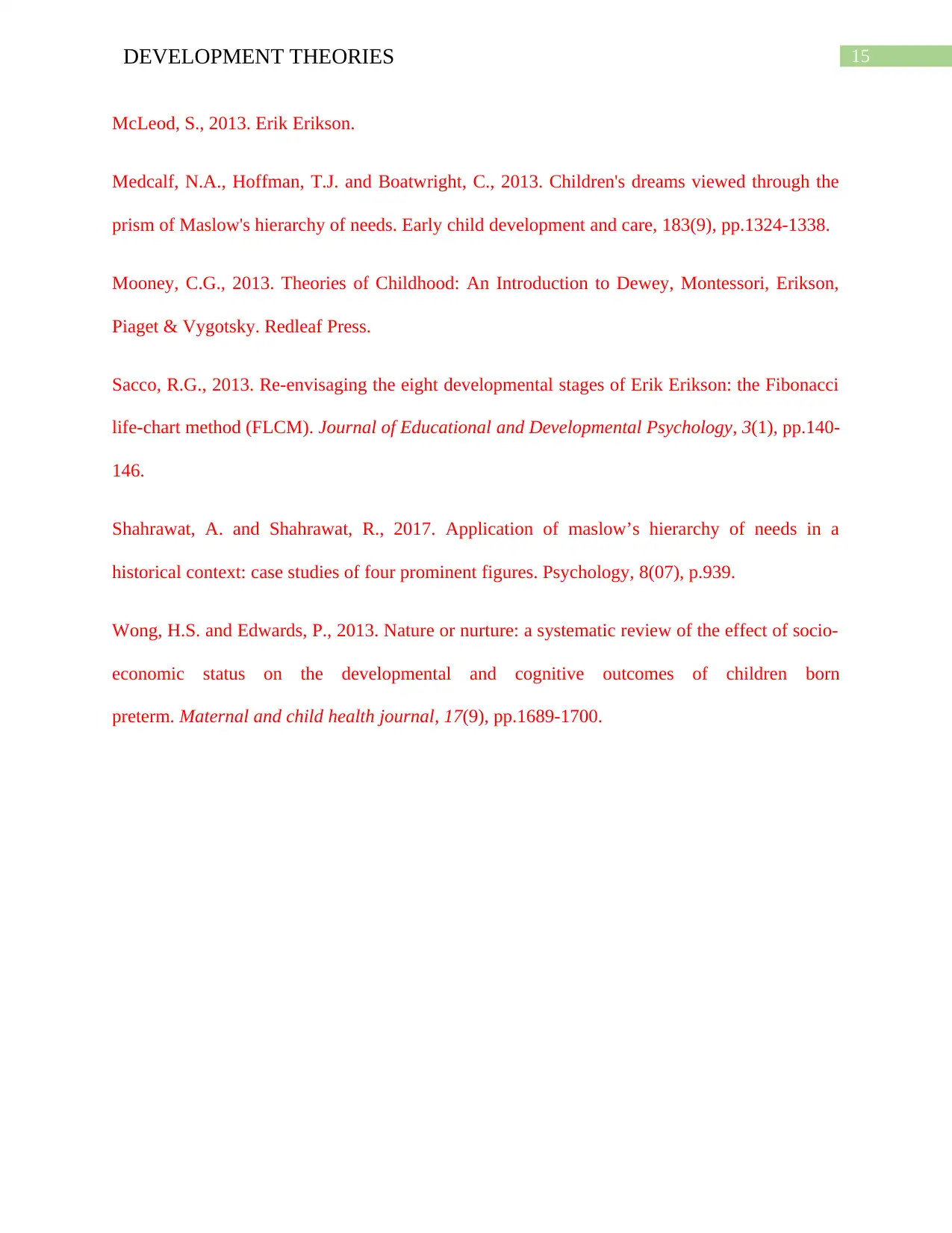
15DEVELOPMENT THEORIES
McLeod, S., 2013. Erik Erikson.
Medcalf, N.A., Hoffman, T.J. and Boatwright, C., 2013. Children's dreams viewed through the
prism of Maslow's hierarchy of needs. Early child development and care, 183(9), pp.1324-1338.
Mooney, C.G., 2013. Theories of Childhood: An Introduction to Dewey, Montessori, Erikson,
Piaget & Vygotsky. Redleaf Press.
Sacco, R.G., 2013. Re-envisaging the eight developmental stages of Erik Erikson: the Fibonacci
life-chart method (FLCM). Journal of Educational and Developmental Psychology, 3(1), pp.140-
146.
Shahrawat, A. and Shahrawat, R., 2017. Application of maslow’s hierarchy of needs in a
historical context: case studies of four prominent figures. Psychology, 8(07), p.939.
Wong, H.S. and Edwards, P., 2013. Nature or nurture: a systematic review of the effect of socio-
economic status on the developmental and cognitive outcomes of children born
preterm. Maternal and child health journal, 17(9), pp.1689-1700.
McLeod, S., 2013. Erik Erikson.
Medcalf, N.A., Hoffman, T.J. and Boatwright, C., 2013. Children's dreams viewed through the
prism of Maslow's hierarchy of needs. Early child development and care, 183(9), pp.1324-1338.
Mooney, C.G., 2013. Theories of Childhood: An Introduction to Dewey, Montessori, Erikson,
Piaget & Vygotsky. Redleaf Press.
Sacco, R.G., 2013. Re-envisaging the eight developmental stages of Erik Erikson: the Fibonacci
life-chart method (FLCM). Journal of Educational and Developmental Psychology, 3(1), pp.140-
146.
Shahrawat, A. and Shahrawat, R., 2017. Application of maslow’s hierarchy of needs in a
historical context: case studies of four prominent figures. Psychology, 8(07), p.939.
Wong, H.S. and Edwards, P., 2013. Nature or nurture: a systematic review of the effect of socio-
economic status on the developmental and cognitive outcomes of children born
preterm. Maternal and child health journal, 17(9), pp.1689-1700.
1 out of 16
Related Documents
Your All-in-One AI-Powered Toolkit for Academic Success.
+13062052269
info@desklib.com
Available 24*7 on WhatsApp / Email
![[object Object]](/_next/static/media/star-bottom.7253800d.svg)
Unlock your academic potential
© 2024 | Zucol Services PVT LTD | All rights reserved.





